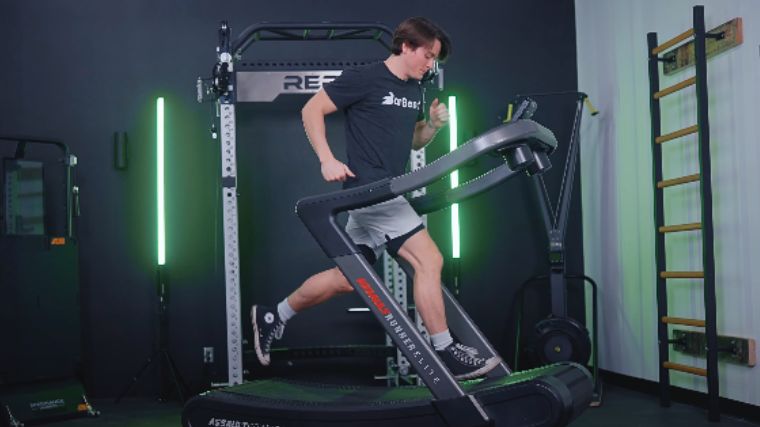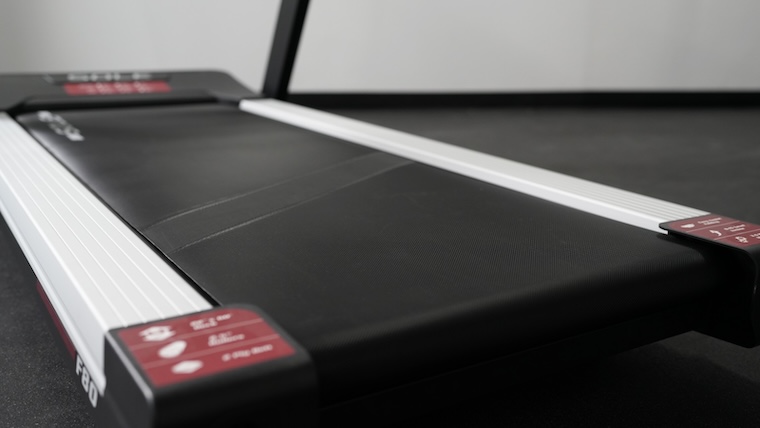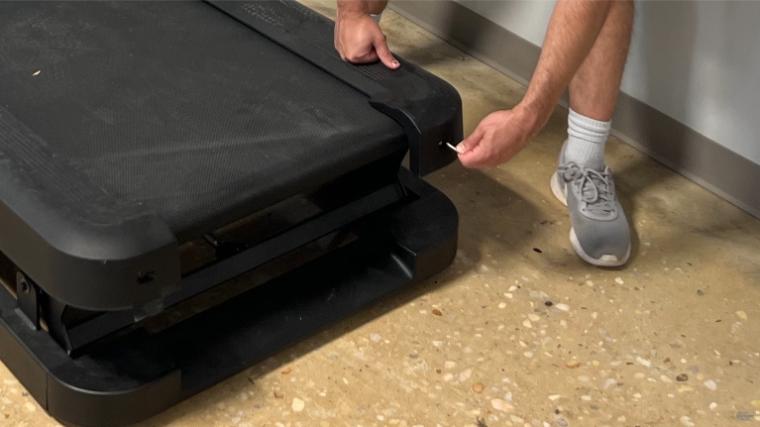The history of treadmills is quite intriguing — it’s wild to think that the best treadmills currently on the market evolved from a method of torture during the Industrial Age. (1) And they’re only becoming more popular. Market insights project the home fitness equipment market will grow from $11.60 billion in 2023 to a staggering $16.56 billion by 2030. (2)
As a personal trainer who spends a lot of time in commercial fitness environments, I love having the option and convenience of getting my workout done on my treadmill at home.
“Even if you don’t use a treadmill daily, it’s a great item to have for instances in which you can’t or don’t want to walk or run outside, such as in bad weather, when the sun sets earlier in the day, or you can’t get to a safe route,” says BarBend expert reviewer Amanda Capritto, CPT, CES, CNC, CF-L1, CSNC.
The benefits of treadmills are aplenty, but what happens when your fitness equipment needs maintenance? Unless you have a professional technician on hand, you’ll need to know how to maintain your home treadmill. Understanding how to adjust a treadmill belt is one of the main tasks you’ll need to know.
Why Your Treadmill Belt is Slipping and Sliding
If your treadmill is suddenly more rickety than usual, you have a couple of choices; call a technician, dust off the long-lost user manual, or learn the basics of your treadmill so you can perform the necessary treadmill maintenance your fitness equipment requires.

If you live by the YOLO motto, you could splurge on one of the best treadmills on the market, but if a new NordicTrack treadmill isn’t in the budget, read on.
[Related: NordicTrack EXP 7i Treadmill Review]
Performing a belt adjustment to your treadmill may seem daunting, but it isn’t necessarily hard. It requires attention to detail and a little patience, but it’s manageable even if you’re not mechanically inclined.
My advice as a gym manager and owner of a home treadmill is to save the call to the tech, refer to your user manual for specifics, and do a little treadmill 101 to help you with your ongoing treadmill maintenance. Let’s jump in.
Running Belt
One of the main problems that treadmill owners run into (no pun intended) is a malfunctioning belt. The running belt can also be referred to as the walking belt or treadmill belt, but not to be confused with the drive belt that transfers power from the motor to the treadmill’s running belt.
If you suspect something is wrong with your treadmill running belt, it could be something as simple as dirt or debris on the belt or treadmill deck, which can be resolved with regular cleaning.
Other issues could be an uneven surface, motor issues, or exceeding the weight capacity. But commonly, the issue is a result of improper belt tension or a lack of lubrication.
Treadmill Belt Tension
A loose belt can cause belt slipping. Conversely, an over-tightened belt can cause friction and also lead to slipping — not to mention cause unnecessary wear and tear on your treadmill walking belt.
From the best budget treadmills to high-end models, all treadmills require regular maintenance and belt alignment, especially for high-use units and ones used for high-intensity workouts.

“Treadmills built with running in mind, specifically, are designed to support high-volume use at high speeds,” says BarBend expert reviewer Amanda Capritto, CPT, CES, CNC, CF-L1, CSNC. “They can withstand the daily foot-pounding work a runner will use it for, and should come with good warranties.”
Even though they’re built for durability, even the best treadmills for running need some TLC to keep them in prime condition.
Clues that your treadmill might need a belt adjustment:
- The treadmill belt is visibly further to the right or left side
- Skipping or sticking feeling during use
- The treadmill belt looks loose on the running deck
- Visible tears, cracks, or fraying edges on one side
- Strange noises
Lubrication
Another culprit of a not-so-smooth treadmill operation could be inadequate lubrication. If you’re unsure of how to lubricate a treadmill, it’s an easy process that can be done while checking your treadmill’s belt tension.
A thin layer of lube between the walking belt and treadmill deck can help reduce friction, enhance traction, prevent wear and tear, maintain belt tension, and increase the overall performance of your treadmill.
How to Loosen a Treadmill Belt
If you suspect your treadmill belt needs to be loosened, try to lift the belt 3-4 inches from the treadmill deck. If you’re not able to do that, here are some steps you can take to loosen the treadmill belt tension.
Step 1
Turn your treadmill off and ensure the power cord is disconnected from its power source.
Step 2
Locate the adjustment bolts — typically hexagonal or Allen bolts — which are down at the endcap of your treadmill by the rear roller. Each treadmill manufacturer is different so refer to your user manual for specific instructions. (Adjustment bolts can also be referred to as tension bolts, roller adjustment bolts, or rear roller bolts.)
Step 3
Depending on your treadmill manufacturer, use a hex key or Allen wrench in the adjustment bolts to complete a quarter turn to the left side, alternating between the bolts to ensure they’re equally adjusted.

Once these steps have been taken, slide your hand between the treadmill deck and the walking belt. If you can lift the belt 3 to 4 inches, you’ve adjusted the belt to the proper tension. Now is also a good time to lube your treadmill if it hasn’t been done recently.
[Related: Best Folding Treadmills]
How to Tighten a Treadmill Belt
A treadmill belt that’s too tight can cause belt slipping and issues with your machine’s performance, and a loose belt can do the same.
Do a visual check for sagging, shifting to one side consistently, or slippage between the belt and the treadmill deck. Here are the steps for how to tighten your treadmill belt.
Step 1
Turn your treadmill off and ensure the power cord is disconnected from its power source.
Step 2
Locate the roller adjustment bolts near the rear roller at the endcap of your treadmill.
Step 3
Use a hex key or Allen wrench to turn both bolts to the right side in one-quarter increments. Complete the quarter turn on each side, alternating between the roller adjustment bolts to ensure equal belt tension on each side.
Overtightening can cause additional issues so be sure to get to the proper tension by checking that the belt can lift 3 to 4 inches from the running deck.
How to Align a Treadmill Belt
A visual check for misalignment or excessive wear on one side of the running belt can cue you into whether your running belt needs to be realigned.

If there are visible signs or you hear squeaking, grinding, or other strange noises with the treadmill on, follow these steps to bring your treadmill belt alignment back to center.
Step 1
Turn your treadmill off and ensure the power cord is disconnected from its power source.
Step 2
Locate the adjustment bolts at the endcap of your treadmill. Whichever side the running belt has shifted towards will need to be tightened. If your belt has shifted left, tighten the left rear roller bolt by turning the appropriate wrench one-quarter to the right. Contrarily, if it’s shifted to the right side, tighten the right rear roller with a quarter turn to the right.
[Related: Treadmill Motors: What You Need to Know]
Repeat this step with quarter-turn increments until the roller pushes the running belt to the other side, bringing the belt to the center.
Step 3
Use your hands to manually rotate the belt to ensure the treadmill belt alignment stays centered and the belt operation is smooth. This is an optimal time to make sure the belt isn’t too tight or too loose.
If the treadmill belt alignment is centered and the treadmill belt tension is set appropriately, reconnect it to a power source and turn your treadmill on. Set it at a slow speed and do a visual check to ensure the belt stays in alignment.
Final Thoughts
Whether your treadmill walking belt is overtightened, too loose, or misaligned, proper tension and alignment are generally easy enough to fix on your own by completing the steps above. Before getting started, just make sure you have a hex key or Allen wrench on hand.
Staying consistent with routine maintenance will help keep your fitness equipment in optimal condition, provide better workouts, and prolong the life of your investment.
How to Adjust a Treadmill Belt FAQs
Why is my treadmill belt sliding?
Belt sliding is usually caused by misalignment, improper belt tension, lack of lubrication, or in some cases, motor issues.
Which way do you adjust a treadmill belt?
Whichever side the treadmill walking belt is shifting towards is the side that you’ll need to adjust the rear roller bolt.
How do I know if my treadmill belt is off-center?
In most cases, you can visually determine if your belt is off-center by wear, cracks, or tears on one side or the belt consistently shifting to one side.
References
- Shayt, D. H. (1989). Stairway to redemption: America’s encounter with the British prison treadmill. Technology and culture. 30(4); 908-938.
- Home Fitness Equipment Market Size, Share & Industry Analysis. (2024, March 1). Fortune Business Insights.